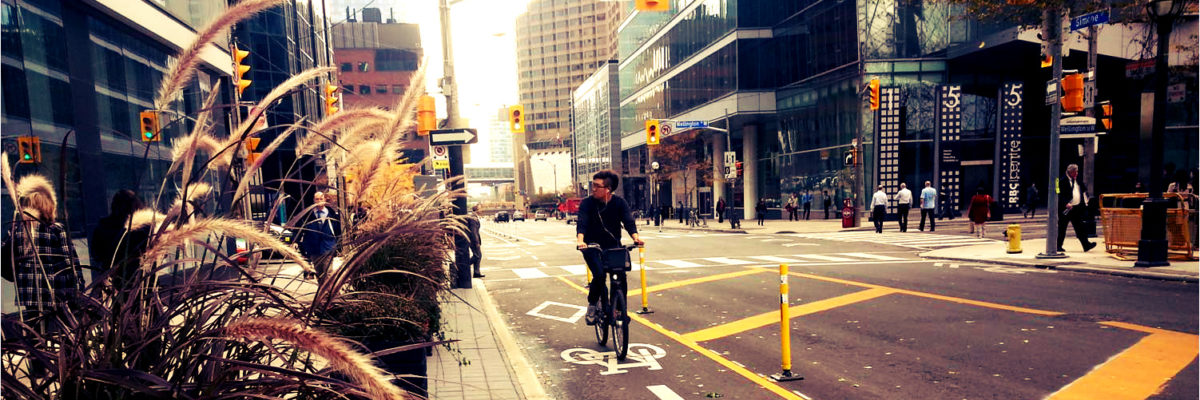Guest blog post by Nancy Smith Lea, Director, Toronto Centre for Active Transportation
Imagine a place with a population the size of Regina, Windsor or Oakville, where virtually 100% of trips between 9 a.m. and 5 p.m. are on bike or by foot. This is not a flight of fancy, it’s a real place and it’s called Toronto’s financial district.
According to a new study by Toronto Financial District Business Improvement Area (BIA), as reported in the Toronto Star last week, 200,000 people (the population of a mid-size Canadian city) stream into a 15 square block area in downtown Toronto five days a week. They arrive by public transit (70%), active transportation (16%), or car (14%). This is consistent with other areas of the downtown, such as Bloor Street where research (2009, 2010) by the Toronto Centre for Active Transportation (TCAT) found that only10-20% of people are driving to local businesses; overwhelmingly customers arrive by walking, cycling and transit.
How people are commuting to the area is of interest, but what’s also quite fascinating is the importance of the PATH system for these thousands of people working in the area’s office towers. The PATH is Toronto’s infamous underground pedestrian network, the largest underground shopping complex in the world. 73% of workers surveyed in the financial district use the PATH daily. Suffice to say that 100% of those customers are on foot. The BIA refers to the PATH as a “huge economic driver,” and they’re right.
But let’s move from the pedestrian tunnels to street level and think about what’s going on each and every day in the financial district. Even if you’ve driven to work, when it’s time to step out of your office to grab a coffee, meet a friend for lunch, pick up your dry cleaning, go the drug store, or do some banking, chances are pretty good that you’re going to leave your car parked right where it is and either walk, hop on a Bike Share Toronto bike, or perhaps jump in a cab. In other words, virtually none of those daytime trips are by car. With all of that demand, we need further improvements to accommodate active transportation in the financial district.
Here are my three recommendations:
1) Improved Pedestrian Environment. A plan to vastly improve the pedestrian environment needs to be prioritized, as is so compellingly called for in the BIA’s Public Realm Strategy. The public realm is defined as the physical space in between buildings, including roads, sidewalks and parks. Recognizing how critical public space is as an economic stimulator, the BIA undertook a thorough analysis of the state of the public realm and found lots of room for improvement, including wayfinding, consistent sidewalks, trees, benches, and lighting. One surprising finding in the study that didn’t get much attention was that sidewalks comprise only 18% of the public realm and and less than 1% are public parks. For an area with 200,000 pedestrians milling about every day, this space allocation is clearly inadequate.
2) More Cycling Infrastructure. High-quality, safe cycling infrastructure is critically needed in Toronto’s east-west arterial downtown streets. In 2014 the City of Toronto installed separated bike lanes along Simcoe, Richmond and Adelaide Streets as a pilot project. City staff found that these new lanes have dramatically increased, in some cases tripled, the number of cyclists using those routes without impeding car travel along the same stretches. Earlier this year the City of Toronto approved the extension of the Richmond/Adelaide lanes to Parliament Street but, partly due to objections expressed by the BIA, there will likely continue to be a gap in the Adelaide bike lane through the financial district, which significantly impacts not only on the safety and comfort of cyclists, but the beautification of the public realm. It could also impact on the area’s bottom line, as numerous studies have found that bikes are good for business.
3) Amenities for Residents. The needs of the people who live in the area should be elevated. Despite the huge numbers of commuters, this is no longer only an office district. Recent years has seen an explosion of population growth in the core, including young families. These people are moving downtown so they are close enough to work to walk and bike. While an underground tunnel of services works well for the office crowd, residents need services, restaurants and shops above ground that they can access in the evenings and weekends. While currently representing only a fraction of the area’s daily population, these residents serve an important “eyes on the street” community safety function for the area, especially after hours.
There is an incredibly impressive amount of active transportation taking place in the bowels of Toronto’s financial district. It’s time to bring it out into the light, celebrate, and enhance it.
Nancy Smith Lea is the Director of the Toronto Centre for Active Transportation, a project of the registered charity Clean Air Partnership. Find out more about TCAT’s work at www.tcat.ca including their upcoming 8th annual Complete Streets Forum on October 1, 2015.

